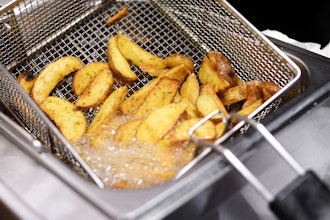READING, Pa. (AP) — For someone who doesn't like zucchini, Alyssa Mikes sure was raving about it in her school cafeteria.
"I like it because I like the tomato sauce," the Wilson High School senior said after taste-testing a hot dish of sliced zucchini in a sauté of tomatoes, garlic and Italian spices.
Getting kids and teens to eat veggies they wouldn't normally eat is possible, but there's a right way and a wrong way to go about it, according to chef Bill Scepansky, who helped Wilson cooks prepare the zucchini recipe and a cold tomato salad last month.
"You can't just put eggplant on a plate and say, 'Today, we're having eggplant,' " he said.
But by adding some skillfully cooked eggplant into a ratatouille of zucchini, garlic, tomatoes and other fresh vegetables, Scepansky said, the eggplant has a chance to sing.
Scepansky is the sole chef for Smart Partner, a Lancaster-based business that helps schools and other establishments incorporate fresh produce into their menus.
Wilson School District recently hired him to come to the high school once a month and help cooks come up with kid-friendly healthy menu options in line with the requirements of the U.S. Department of Agriculture's $11 billion National School Lunch Program.
That way, the district hopes it can improve declining lunch sales, prevent food from ending up in the garbage and encourage students' appreciation for nutritious fare. Whenever Scepansky is at the school, students will taste-test the new recipes and popular dishes could end up on the regular menu.
Schools have been under pressure to serve healthier lunches with new federal standards, but they have also faced the equally tricky challenge of getting kids to eat the lighter fare. Like Wilson, other Berks County school districts have consulted with chefs to make their meals more appealing.
The National School Lunch Program reimburses districts for meals served, and started requiring more fruits, veggies and whole grains last year. It also limits calories and sodium content, among other restrictions.
Since the new rules went into effect, about 1 percent of the schools nationwide have dropped out of the program because too many kids stopped buying meals, according to a report by The Associated Press.
The report stated that another 3 percent of the schools were considering a similar option.
While Wilson officials aren't looking to drop out, they want to see sales go up.
Last year, Wilson sold an average of 3,244 cafeteria meals per day, 109 meals fewer than the year before, said Diane J. Richards, Wilson's director of finance and support services.
Peggy Umbenhauer, Wilson's coordinator of food services, said students will usually eat broccoli, carrots and corn. But they turn up their noses to much of the other produce, she said, including all legume dishes except baked beans.
And because the district has to serve produce from various produce groups, such as legumes and dark green, red and orange vegetables, cafeteria workers can't just serve whatever is popular.
Scepansky believes that by using in-season local produce, which has more time to ripen than shipped fruits and vegetables, dishes will taste better and appeal more to kids.
Herbs, spices and a good presentation are important too, Scepansky said, because if a dish looks good and smells good, kids are more likely to eat it. Plus, the National School Lunch Program requires schools to gradually decrease their sodium use, and herbs and spices are healthy alternatives to salt.
Richards said the decision to have Scepansky come to the high school instead of the elementary or middle schools was based on several factors.
With about 1,800 students, the high school has the biggest population and the best opportunity to improve sales. Officials felt it would also be easier to get feedback from older students.
But Exeter School District, which also hired Scepansky to teach its cooks new recipes, took a different approach. Exeter officials used a grant to pay for Scepansky's coaching in August, and are focusing on the elementary schools.
"We're trying to introduce the different foods at the elementary level so that as they progress through the school system, the kids have already been eating them," said Gloria Clay, Exeter food services supervisor.
Hamburg and Conrad Weiser are two other districts that have also consulted with chefs, and Brandywine Heights outsourced the management of its food service program to a company called School Operation Services last winter.
"They have been very instrumental in helping us develop a lunch program which addresses the needs of the new National School lunch program requirements," said Andrew Potteiger, Brandywine Heights superintendent.
Eventually, Umbenhauer would like to bring Scepansky's dishes to all of Wilson's schools. While students can be a hard group to please, she feels confident that healthier menu items will become more popular with time.
"Ten years ago, we started with grains; I wasn't here at that time, but was told that at first the kids turned up their noses to them," Umbenhauer said. "Now we don't have a problem with whole grains. Whenever a change takes place, you have to give it a certain amount of time."
___
Online:
___
Information from: Reading Eagle, http://www.readingeagle.com/






















